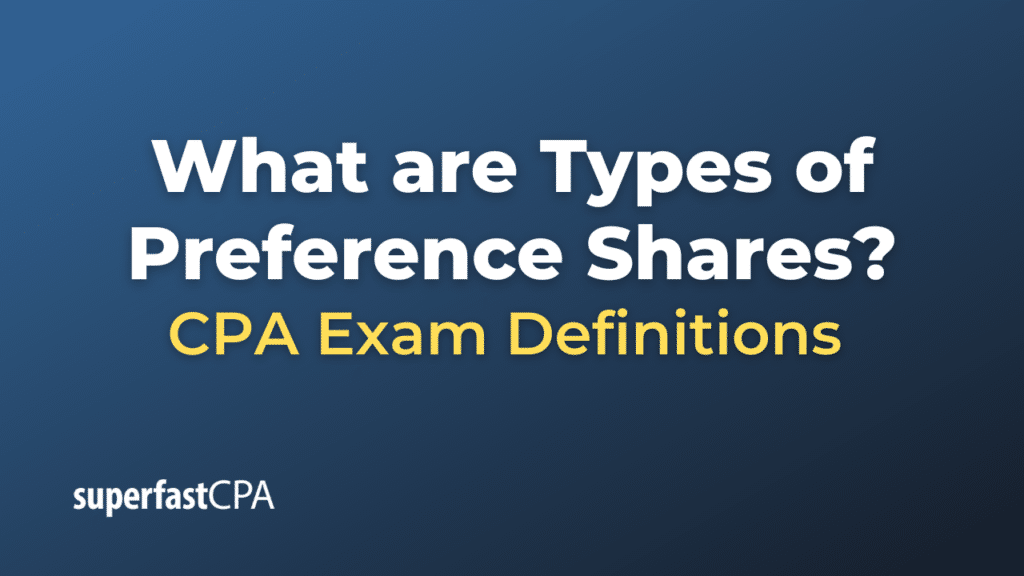Types of Preference Shares
Preference shares, also known as preferred stock, are a type of equity security that entitles holders to a fixed dividend before any dividends are paid to common stockholders. They often also have a greater claim on company assets in the event of liquidation compared to common shareholders.
There are several types of preference shares:
- Cumulative Preference Shares: If the company is unable to pay the dividend in a particular year, the dividend accumulates and is paid off in the subsequent years when the company has sufficient profits. The accumulated dividends must be paid before any dividend is paid to common shareholders.
- Non-Cumulative Preference Shares: Unlike cumulative preference shares, missed dividends do not accumulate for future payment. If the company does not declare a dividend in a particular year, the shareholder loses the dividend for that year.
- Participating Preference Shares: These shareholders have the right to participate in the surplus profits of the company after the specified rate of dividend has been paid on equity shares. They may also have the right to participate in the surplus assets of the company upon liquidation.
- Non-Participating Preference Shares: These shareholders do not have the right to participate in the surplus profits or assets of the company. Their dividends are limited to a fixed amount or rate.
- Convertible Preference Shares: These shares can be converted into common equity shares after a predetermined date.
- Non-Convertible Preference Shares: These shares cannot be converted into common equity shares.
- Redeemable Preference shares: These shares are issued with the understanding that the company will buy them back after a certain period or on a specific date. The terms of redemption are predetermined.
- Irredeemable Preference Shares (or Perpetual Preference Shares) : These shares do not carry any date of redemption which means the company is not under an obligation to return the capital during its lifetime. These are not commonly issued, as many jurisdictions do not allow for shares without a redemption date.
The particular rights and features of preference shares can vary greatly from one company to another, and they are laid out in the company’s articles of association. Investors should thoroughly understand these rights before investing in preference shares.
Example of Types of Preference Shares
Let’s consider a hypothetical company called “FutureTech Ltd.” that decides to issue preference shares to raise capital. Let’s look at several types of preference shares that FutureTech Ltd. might issue:
- Cumulative Preference Shares: If FutureTech is unable to pay dividends in a year due to low profits, shareholders with cumulative preference shares would have their unpaid dividends accumulate. FutureTech would then have to pay these accumulated dividends in a future year before any dividends are paid to common shareholders.
- Non-Cumulative Preference Shares: If FutureTech issued non-cumulative preference shares and could not pay a dividend in a certain year, those shareholders would not receive a dividend for that year and would not have the right to any missed dividends in the future.
- Participating Preference Shares: If FutureTech has a profitable year, participating preference shareholders could receive a higher than normal dividend. This is because they’re entitled to a share of surplus profits in addition to the fixed dividend rate.
- Non-Participating Preference Shares: Holders of these shares would only receive the fixed dividend, regardless of how profitable FutureTech is. They would not be entitled to any surplus profits.
- Convertible Preference Shares: Holders of these shares would have the option to convert their preference shares into common shares of FutureTech after a predetermined period.
- Redeemable Preference Shares: FutureTech would have the right or the obligation to buy back these shares at a future date, effectively “redeeming” them.
Remember, the specific terms and conditions of these preference shares, including dividend rates and dates of redemption or conversion, would be set out in FutureTech’s articles of association or the specific share issuance documentation.













